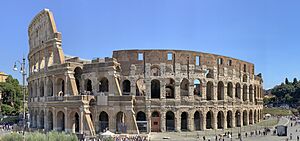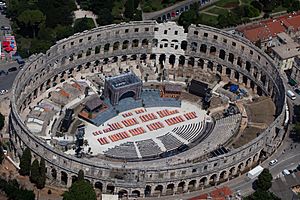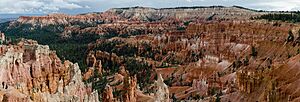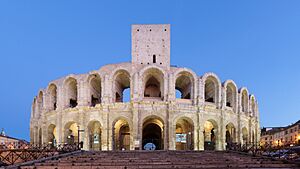Amphitheatre facts for kids

An amphitheatre is a special open-air place used for fun events, shows, and sports. Think of it like a big outdoor stadium. The word comes from ancient Greek. It means "a place for viewing" that is "around" or "on both sides."
Ancient Greek theatres were usually built on hillsides. They had a half-circle shape. The first amphitheatre might have been built in Pompeii around 70 BC. Ancient Roman amphitheatres were shaped like an oval or a circle. They had rows of seats all around a central area where performances happened. This is much like a modern open-air stadium.
In contrast, both ancient Greek and ancient Roman theatres were built in a semicircle. Their seats rose up on only one side of the stage. Today, we use "amphitheatre" for any place with sloped seating. This can include stages with seats on one side, or even theatres where the audience sits all around the stage. They can be indoors or outdoors.
Ancient Roman Amphitheatres

About 230 Roman amphitheatres have been found across the Roman Empire. Their shape and purpose make them different from other Roman buildings. They are not like Roman theatres, which are half-circles. They are also different from circuses, which were long tracks for horse or chariot races. And they are not like small stadia, which were mainly for running and other athletics.
Roman amphitheatres were round or oval. They had a central arena (the performance area). Seats were built in tiers all around this arena. There were special entrances for people to get to their seats. These entrances also kept the audience separate from the arena floor.
Early amphitheatres were often temporary wooden buildings. They were set up for special events called munera. These were like gifts or duties to honor important Romans who had died. These events often featured gladiators, who were usually armed prisoners of war. They would fight to the death to honor the deceased.
Over time, permanent stone amphitheatres were built. The first permanent one was built in Rome in 29 BCE. Most were built during the time of the Roman Emperors, starting around 27 BCE. These grand buildings were built all over the Roman Empire. They showed how important Roman culture was. There was no standard size for them. The biggest ones could hold 40,000 to 60,000 people.
The most famous and largest Roman amphitheatre is the Colosseum in Rome. It is also known as the Flavian Amphitheatre. This name comes from the Flavian family who had it built. After gladiator games ended in the 5th century and animal hunts in the 6th century, most amphitheatres fell apart. Their stones were often used for other buildings. Some were torn down, and others became forts. A few were still used as open meeting places, and some even had churches built inside them.
Modern Amphitheatres

Today, the word "amphitheatre" can mean a circular, semicircular, or curved performance space. These are often outdoors. Modern amphitheatres often have special structures called bandshells. These are curved or bowl-shaped walls behind the stage and sometimes behind the audience. They help to echo or make the sound louder. This makes amphitheatres great for music concerts or plays. Smaller amphitheatres can host local community shows.
Some well-known modern amphitheatres include the Shoreline Amphitheatre and the Hollywood Bowl in the United States. The term "amphitheatre" is also sometimes used for indoor places. Examples include the former Gibson Amphitheatre and the Chicago International Amphitheatre.
Natural Amphitheatres

A natural amphitheatre is a performance area found in nature. It's a place where a steep mountain or a special rock formation naturally makes sound louder or creates an echo. This makes it perfect for music or theatre, even if no stage has been built there. These are natural formations that would be ideal for performances.
Famous natural amphitheatres include the Drakensberg Amphitheatre in South Africa. Others are Slane Castle in Ireland and the Supernatural Amphitheatre in Australia. In the western United States, there are the Red Rocks and the Gorge Amphitheatres.
There is proof that the Anasazi people used natural amphitheatres long ago. They used them for public music performances before Christopher Columbus arrived in America. One large performance area was found in Chaco Canyon, New Mexico.
See also
 In Spanish: Anfiteatro para niños
In Spanish: Anfiteatro para niños
- Odeon (building)
- Colosseum
- Ancient theatres
- Theatre of ancient Greece
- List of ancient Greek theatres
- Arena
- Thingplatz
- List of Roman amphitheatres
- List of contemporary amphitheatres
- List of indoor arenas


